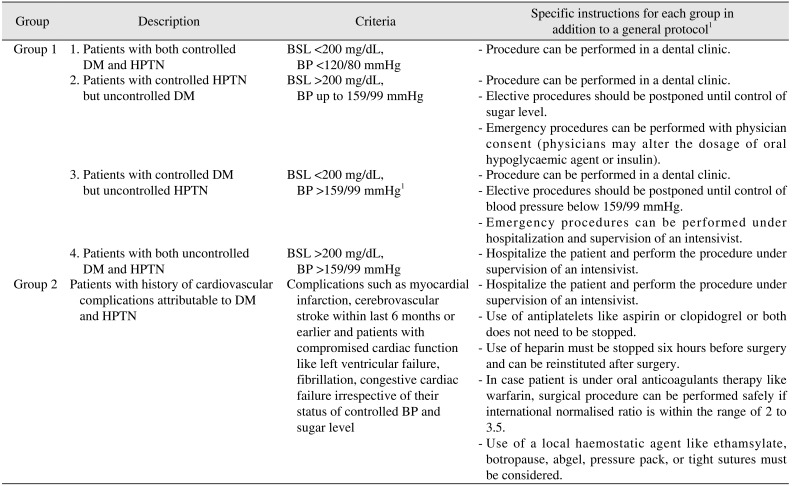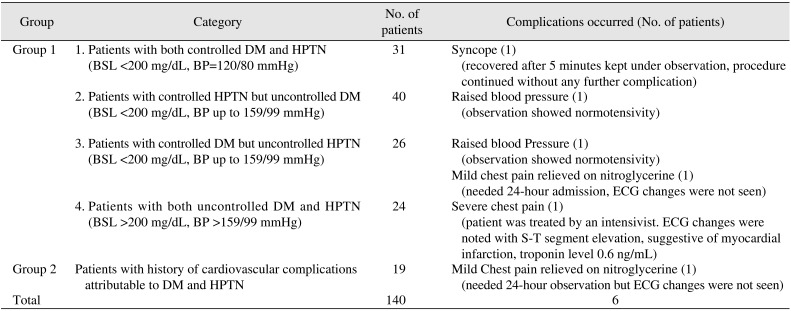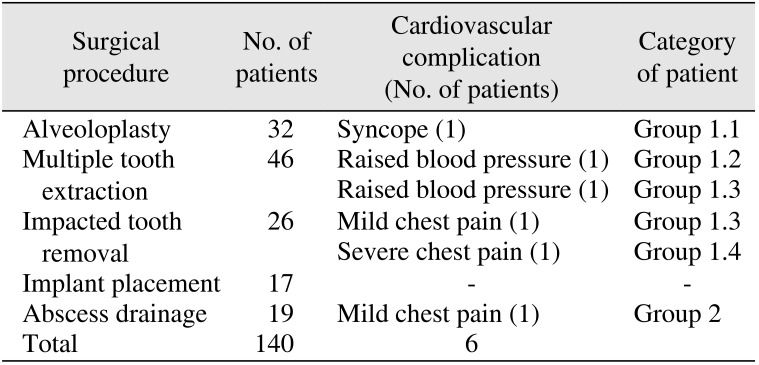1. McCarthy FM, Malamed SF. Physical evaluation system to determine medical risk and indicated dental therapy modifications. J Am Dent Assoc. 1979; 99:181–184. PMID:
287736.

2. McCarthy FM. Stress reduction and therapy modification. CDA J. 1981; 9:41–47.
3. Stamler J, Vaccaro O, Neaton JD, Wentworth D. Diabetes, other risk factors, and 12-yr cardiovascular mortality for men screened in the multiple risk factor intervention trial. Diabetes Care. 1993; 16:434–444. PMID:
8432214.

4. Emerging Risk Factors Collaboration. Sarwar N, Gao P, Seshasai SR, Gobin R, Kaptoge S, et al. Diabetes mellitus, fasting blood glucose concentration, and risk of vascular disease: a collaborative meta-analysis of 102 prospective studies. Lancet. 2010; 375:2215–2222. PMID:
20609967.
5. Hu G, Jousilahti P, Tuomilehto J. Joint effects of history of hypertension at baseline and type 2 diabetes at baseline and during follow-up on the risk of coronary heart disease. Eur Heart J. 2007; 28:3059–3066. PMID:
17981826.

6. Haffner SM, Lehto S, Rönnemaa T, Pyörälä K, Laakso M. Mortality from coronary heart disease in subjects with type 2 diabetes and in nondiabetic subjects with and without prior myocardial infarction. N Engl J Med. 1998; 339:229–234. PMID:
9673301.

7. Cowie CC, Rust KF, Byrd-Holt DD, Eberhardt MS, Flegal KM, Engelgau MM, et al. Prevalence of diabetes and impaired fasting glucose in adults in the U.S. population: National Health And Nutrition Examination Survey 1999-2002. Diabetes Care. 2006; 29:1263–1268. PMID:
16732006.
8. Jacoby RM, Nesto RW. Acute myocardial infarction in the diabetic patient: pathophysiology, clinical course and prognosis. J Am Coll Cardiol. 1992; 20:736–744. PMID:
1512357.

9. Loewen SL, Haas LB. Complications of diabetes: acute and chronic. Nurse Pract Forum. 1991; 2:181–187. PMID:
1840972.
10. Chawla A, Chawla R, Jaggi S. Microvasular and macrovascular complications in diabetes mellitus: distinct or continuum? Indian J Endocrinol Metab. 2016; 20:546–551. PMID:
27366724.

11. Drozdz D, Kawecka-Jaszcz K. Cardiovascular changes during chronic hypertensive states. Pediatr Nephrol. 2014; 29:1507–1516. PMID:
24026758.

12. Nathan DM, Cleary PA, Backlund JY, Genuth SM, Lachin JM, Orchard TJ, et al. Diabetes Control and Complications Trial/Epidemiology of Diabetes Interventions and Complications (DCCT/EDIC) Study Research Group. Intensive diabetes treatment and cardiovascular disease in patients with type 1 diabetes. N Engl J Med. 2005; 353:2643–2653. PMID:
16371630.

13. Martín-Timón I, Sevillano-Collantes C, Segura-Galindo A, Del Cañizo-Gómez FJ. Type 2 diabetes and cardiovascular disease: have all risk factors the same strength? World J Diabetes. 2014; 5:444–470. PMID:
25126392.

14. Haynes SR, Lawler PG. An assessment of the consistency of ASA physical status classification allocation. Anaesthesia. 1995; 50:195–199. PMID:
7717481.

15. Hogan J, Radhakrishnan J. The assessment and importance of hypertension in the dental setting. Dent Clin North Am. 2012; 56:731–745. PMID:
23017548.

16. Barnes JN, Joyner MJ. Physical activity and cardiovascular risk: 10 metabolic equivalents or bust. Mayo Clin Proc. 2013; 88:1353–1355. PMID:
24290107.

17. Southerland JH, Gill DG, Gangula PR, Halpern LR, Cardona CY, Mouton CP. Dental management in patients with hypertension: challenges and solutions. Clin Cosmet Investig Dent. 2016; 8:111–120.
18. Findler M, Galili D, Meidan Z, Yakirevitch V, Garfunkel AA. Dental treatment in very high risk patients with active ischemic heart disease. Oral Surg Oral Med Oral Pathol. 1993; 76:298–300. PMID:
8378044.

19. Niwa H, Sato Y, Matsuura H. Safety of dental treatment in patients with previously diagnosed acute myocardial infarction or unstable angina pectoris. Oral Surg Oral Med Oral Pathol Oral Radiol Endod. 2000; 89:35–41. PMID:
10630939.

20. Jick H, Kaye JA, Russmann S, Jick SS. Nonsteroidal antiinflammatory drugs and acute myocardial infarction in patients with no major risk factors. Pharmacotherapy. 2006; 26:1379–1387. PMID:
16999647.

21. Cintron G, Medina R, Reyes AA, Lyman G. Cardiovascular effects and safety of dental anesthesia and dental interventions in patients with recent uncomplicated myocardial infarction. Arch Intern Med. 1986; 146:2203–2204. PMID:
3778050.

22. Lu SY, Tsai CY, Lu SN, Lin LH. Is alteration of warfarin regimen necessary before dental extractions in Taiwanese patients? Results of a retrospective cohort study? J Dent Sci. 2015; 10:352–358.

23. Bajkin BV, Urosevic IM, Stankov KM, Petrovic BB, Bajkin IA. Dental extractions and risk of bleeding in patients taking single and dual antiplatelet treatment. Br J Oral Maxillofac Surg. 2015; 53:39–43. PMID:
25311541.

24. Lee JK. Dental management of patients on anti-thrombotic agents. J Korean Assoc Oral Maxillofac Surg. 2018; 44:143–150. PMID:
30181980.

25. McCarthy FM. Sudden, unexpected death in the dental office. J Am Dent Assoc. 1971; 83:1091–1092. PMID:
5286141.

26. Yoon HJ, Lee SH, Song HC. The influences of epinephrine and pain on the changes of systolic blood pressure and pulse rates in mandibular 3rd molar extraction. J Korean Assoc Oral Maxillofac Surg. 2001; 27:556–559.








 PDF
PDF ePub
ePub Citation
Citation Print
Print



 XML Download
XML Download